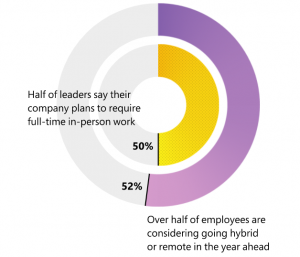It has been almost two years since we all shifted to new ways of working.
With the lived experience of remote work and now having tested the hybrid work over the last year, – a blended model of workplace and home – the flexibility is here to stay.
According to the 2022 Work Trend Index Report published by Microsoft, 53% of people are likely to consider transitioning to hybrid in the year ahead.
Key Takeaways
1- Employees have a new “worth it” equation:
Employees had time to re-evaluate their priorities and expectations are higher than ever. They want flexibility and face time and are making career changes that prioritize personal goals and well-being.
The workforce is still in transition with 57% of remote employees considering a shift to hybrid while 51% of hybrid employees are considering a shift to remote. The challenge ahead for every organization is to meet employees’ great new expectations while balancing business outcomes in an unpredictable economy.
2- Managers feel wedged between leadership and employee expectations.
Over half of managers (54%) feel leadership at their company is out of touch with employee expectations. And 74% say they do not have the influence or resources they need to make changes on behalf of their team.
Many leaders say their company is planning a return to the office full time within the next year, but majority of employees prefer the flexibility of remote and hybrid work.
Empowering managers to adapt to new employee expectations helps set organisations up for long-term success.

3- Leaders need to make the office worth the commute.
More than a third (38%) of hybrid employees say their biggest challenge is knowing when and why to come into the office. Yet few companies (just 28%) have established team agreements to clearly define the new norms.
Leaders must establish the why, when, and how of the office. This means defining the purpose of in-person collaboration, creating team agreements on when to come together in person, defining hybrid meeting etiquette, and rethinking how space can play a supporting role.
4- Flexible work does not have to mean “always on.”
Since February 2020, the average Teams user saw a 252% increase in their weekly meeting time and the number of weekly meetings has increased 153%. Work is more flexible, but digital overload is still a risk. Making flexible work sustainable long-term will require new team norms to guard against being “always on.”
5- Rebuilding social capital looks different in a hybrid world.
One of the most felt aspects of remote and hybrid work is the impact it has had on our relationships.
In a digital-first work world, while majority (58%) of hybrid employees seem to be maintaining their work relationships, only half (48%) of remote workers say they have a thriving relationship with their direct team. Leaders should prioritize time for relationship-building to happen, knowing remote and newly onboarded employees will need extra support.
Going Forward
The managers need to rethink the role of the office, rebuild social capital for a digital-first workforce, and create new practices for sustainable flexible work. Hybrid work requires a deliberate, thoughtful approach and begins with the culture. While so much relies on new cultural norms, the transition will also benefit from technologies designed for this hybrid world.
To bridge the gap between digital and physical workspaces and make hybrid work possible for all employees, Microsoft empowers organisations with the latest innovative solutions like Outlook RSVP, Teams Rooms with Front Row, Teams Connect.
At CloudSource, we aim to create a workplace that works for everyone. With a growth mindset, we empower our employees with the right support and tools to develop new skills and adapt to new ways of working where they have the flexibility to build a work routine around their needs and priorities.
Full report and data resource: Microsoft 2022 Work Trend Index Report
Email: ozlem.kilavuz@cloudsource.uk.com
Teams. +44 (0)1156 782 043
